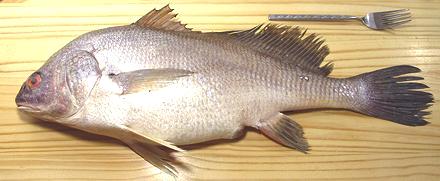 [Gasper goo, Gaspergou, Sheepshead, Lake/River drum, Grunt, Croaker,
Aplodinotus grunniens]
[Gasper goo, Gaspergou, Sheepshead, Lake/River drum, Grunt, Croaker,
Aplodinotus grunniens]
In the Asian markets of Southern California this fish has most often been labeled "Sheephead" but the Philippine markets are now more commonly calling it "Gasper goo". This is a pretty big fish, the photo specimen at 21 inches and 3.85 pounds, but they can grow to over 3 feet and 50 pounds. Found in large non-freezing lakes and rivers in North and Central America, it is a minor commercial fish and not considered threatened.
More on Croakers & Drums.
The flesh of this fish is medium in color and fairly mild in flavor. It holds together very well for most methods of cooking, in fact the flesh is a bit gelatinous and does not flake apart easily. This makes it rather good for soup.
Buying: This fish is found in many Asian fish markets. It is not a fast moving fish so be careful about freshness. I have yet to find one that's odorless, but the smell should not be strong and the eyes and gills should look fresh. It is an inexpensive fish, often as low as 2013 US $0.99/pound.
Scales: Like other croakers and drums, this fish is covered with large thick tightly adhering scales that take a bit of energy to scrape off, and they fly about far and wide.
Cleaning: There's a lot of stuff inside, including a fair amount of yellow body fat in the cavity and a large swim bladder. It has very small teeth but an impressive set of millstones in its throat for crushing mollusks. These make gill removal a bit different than most fish. I would cut off the head, then cut the collar loose under the chin and bend it back until it breaks off. Then the whole gill / grindstone assembly can be easily removed as a single unit. Actually, since I don't really like the stock made from this fish, I usually just toss head complete.
Fillet: This is a fairly easy fish to fillet with an easy to follow bone structure. First cut off the head assembly. As usual, cut through the skin to outline the fillet top, bottom and across the tail. Fillet downward to the backbone front to back, then over the backbone at the tail and work forward. When you get to the ribcage, cut the ribs from the backbone with kitchen shears. Pull the ribs from the fillet with your long nose pliers. The ribs don't pull easily but if you start from the rear of the body cavity they come out easier. There will also be some substantial centerline spines for the first inch or two. Pull them out straight forward. They pull fairly hard and tend to break off.
If the skirt region is stained, it has probably been exposed to the innards too long and will have an "off" taste so should be discarded. If white and fresh looking it will still have a bit stronger taste than the rest of the flesh, but this may not be a problem depending on use.
Skin: The skin does not have a strong or "off" flavor. and cooks up somewhat gelatinous. It does have quite a bit of initial shrink, so needs to be removed for pan frying or poaching. This is easily done by the long knife and cutting board Method.
Yield: The 3 pound 14 ounce photo specimen yielded 1 pound 6-1/2 ounces of skin-on fillet (37%), 1 pound 3-3/8 ounces skin-off (32%). Not real high, but what you expect from a croaker. A larger fish will yield a bit better, a smaller one less.
Stock: The head, fins and bones make a stock that's a little cloudy, a little harsh in flavor and a bit stronger in smell than I prefer.
sf_drumfwz 060715 - www.clovegarden.com